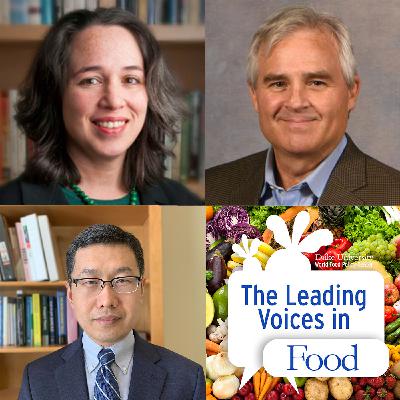E279: Feed Us With Trees - the surprising importance of nuts
Description
Every day, with few exceptions, I eat a handful of nuts. Usually a combination of almonds, walnuts, pecans, cashews, and pistachios. And they taste good for sure. But I'm responding mainly to research showing that consumption of nuts is related to less chronic disease. In particular, eating nuts lowers levels of inflammation related to heart disease and diabetes, and may improve cholesterol levels among other benefits. So, I saw it as welcome news that someone has just published a book about nuts, all aspects of nuts, actually. Today we're joined by NPR, food Writer Elspeth Hay author of a new book called Feed Us with Trees- nuts, and The Future of Food. And I had no idea. Nuts were so interesting until I dove in a little bit. Elspeth has gathered stories from dozens of nut growers, scientists, indigenous knowledge keepers, researchers and food professionals. She writes that humans once grew their staple crops in forest gardens of perennial nuts, such as oaks, chestnuts, and hazelnuts in these species. Particularly important to the environment as well as to human wellbeing.
Interview Summary
Elspeth, thanks so much for joining us and for writing such an amazing book.
Thank you so much for having me. And it sounds like you have the same habit as my dad. He makes sure to eat a little bit of mixed nuts every night, ever since I can remember for his health.
Let’s start by having you describe your book. Tell us about Feed us with Trees. Why did you write it and what's it about?
I wrote it because I've been reporting on food in the environment for a long time, a little more than 15 years. And I had never heard anyone mention anything about eating acorns until a few years ago. And someone sent me a TEDx talk by a woman in Greece named Marcie Mayer, and she said, you can eat acorns. And not only that, but they're a super food nutritionally, and one of humanity's oldest foods. And I live in this giant oak forest that's protected on Cape Cod as part of the Cape Cod National Seashore. And I had always seen this forest as a sort of impediment to local food production, right? There's all this land that can't be farmed. And all that time, it turns out there was food literally raining down on my roof, underfoot in my driveway, and I just wasn't equipped to see it. The stories that I had grown up with hadn't mentioned that. And so that was a real eyeopener for me and I just couldn't stop thinking about it and I kept researching.
So, have you started consuming acorns?
I have, yes. I've collected them the past probably five falls and, you know, oaks do something called masting. Some years they have a really big production and some years smaller production. Some years I've gotten more than others. But I have started processing them at home and experimenting with different ways of using the flour. And I've also ordered online acorn oil. There are actually three food products that you can make from acorns. You can make starch, which works just like corn starch or potato starch. Thickens things. You can make flour and with some species you can make oil. It's actually a pretty diverse crop.
That's so interesting. You know, I have a series of oak trees right outside my window and I never thought that they might be producing food I could consume. It's so interesting to hear your history with that.
Yes, I mean I had no idea. And it turns out that actually acorns are very similar to olives in the way that they need to be processed. They're very high in these compounds that are very bitter, called tannins, just like an olive. I had the experience once of going to Italy with my husband, and we saw this olive grove and we thought, oh cool. Olives growing right here. And we picked one off the tree and he put his in his mouth and immediately spat it out and said, oh, that's awful. Tannins are not something that we want to eat. They don't taste good, but obviously they haven't hampered the olives rise to glory in terms of a human food source. And Acorns need the same kind of processing. So, tannins are water soluble. You pull them out with water. You know, you always get olives in brine, right? And so Yes, just started learning more about how to work with them and then also more about our relationship with oak trees. And I started seeing them differently in that light too. Going from sort of the species that I'd always seen as natural and wild and better off without humans, to actually understanding that we have a really long history with oak trees and in some places, they actually really depend on us. So that was total game changer for me.
There's more to the story than oaks and acorns. Tell us what you learned about the history of humans eating nuts like acorns, but also things like chestnuts and hazelnut.
Yes, I was really surprised. At first, I thought, okay, this is going to be an isolated thing where some people in really hilly areas or areas that aren't good for row crops are eating these nuts as staple foods. But when I looked back, actually all over the Northern Hemisphere in a huge variety of cultures, people have been in relationship with these nut trees as a staple food for a lot of the past 12,000 years. So, there's records in Japan of this ancient society that was sort of the first known chestnut cultivators in Japan. The burr size increased a lot. The nut size increased a lot during that early era of cultivation. There's a really interesting history of chestnut cultivation throughout Europe during what we call the quote unquote dark ages, although I'm starting to think maybe it was lighter than we thought during that time. There was a lot of cool stuff happening with Agroforestry. And in some areas of Europe, people ate an average of 330 pounds of chestnuts per person, per year. To put that in perspective, today, the average American eats about 150 pounds of grains per person per year. So that is a pretty serious level of chestnut consumption. You know, it's called in some places the bread tree. And I just started finding all these examples. There was a time in the British Isles known as the Nut Age, between about 7,000 and 5,000 years ago. There were just all these examples of different people at different times tending to these trees and harvesting a huge amount of food from them.
You've written that trees like oaks and chestnut and hazels and also humans are what ecologists call keystone species.
Yes.
Tell us what you mean by that and how such species play an outsized role in local ecosystems.
So, a keystone species, the first time I ever heard of them I think I was in Jamaica, and someone was talking about the sea urchins on the reef and the beach there. And it turned out that when they disappeared, for a variety of reasons, this whole ecosystem fell apart. And there's different types of keystone species, but a keystone species is as important to its ecosystem as the keystone in a Roman arch, right? So, if you pull that keystone out, you have this cascade of effects where everything kind of falls apart. And oaks are a huge life support tree. I don't know if listeners have heard of the work of entomologist, Doug Tallamy. He's done some really interesting studies on different families of plants and how much life they support by looking at insects. And in most counties where they occur, oaks are the top life support plant in North America. They're this incredibly important basis of the food chain. They provide food for a ton of insects. Those insects in turn feed birds and mammals and other creatures. And you know, at first as I am learning all this, I thought, okay, great oaks are important. Well, you know, I kind of already knew that, but that's exciting that we can eat from them. But then I started getting to know some fire practitioners. Especially an indigenous man in present day Northern California named Ron Reed. And he's a member of the Karuk Tribe there. And he started telling me about the relationship between cultural fire, prescribed fire, and oak trees. And what I learned is that oaks and human fire have actually been in relationship for millennia. And there's this whole, on the east coast, this hypothesis called the Oak Fire Hypothesis. And most ecologists that I've spoken with ascribe to it and believe that the reason that white oak and hickory have been this sort of dominant forest type through a l
























